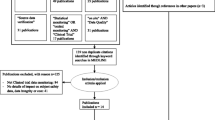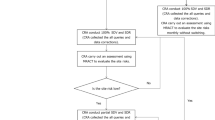Abstract
Background
Computer-aided data validation enhanced by centralized monitoring algorithms is a more powerful tool for data cleaning compared to manual source document verification (SDV). This fact led to the growing popularity of risk-based monitoring (RBM) coupled with reduced SDV and centralized statistical surveillance. Since RBM models are new and immature, there is a lack of consensus on practical implementation. Existing RBM models’ weaknesses include (1) mixing data monitoring and site process monitoring (ie, micro vs macro level), making it more complex, obscure, and less practical; and (2) artificial separation of RBM from data cleaning leading to resource overutilization. The authors view SDV as an essential part (and extension) of the data-validation process.
Methods
This report offers an efficient and scientifically grounded model for SDV. The innovative component of this model is in making SDV ultimately a part of the query management process. Cost savings from reduced SDV are estimated using a proprietary budget simulation tool with percent cost reductions presented for four study sizes in four therapeutic areas.
Results
It has been shown that an “on-demand” (query-driven) SDV model implemented in clinical trial monitoring could result in cost savings from 3% to 14% for smaller studies to 25% to 35% or more for large studies.
Conclusions
(1) High-risk sites (identified via analytics) do not necessarily require a higher percent SDV. While high-risk sites require additional resources to assess and mitigate risks, in many cases these resources are likely to be allocated to non-SDV activities such as GCP, training, etc. (2) It is not necessary to combine SDV with the GCP compliance monitoring. Data validation and query management must be at the heart of SDV as it makes the RBM system more effective and efficient. Thus, focusing SDV effort on queries is a promising strategy. (3) Study size effect must be considered in designing the monitoring plan since the law of diminishing returns dictates focusing SDV on “high-value” data points. Relatively lower impact of individual errors on the study results leads to realization that larger studies require less data cleaning, and most data (including most critical data points) do not require SDV. Subsequently, the most significant economy is expected in larger studies.
Similar content being viewed by others
References
TransCelerate. Position paper: Risk-based monitoring methodology. 2013. http://www.transceleratebiopharmainc.com/wp-content/uploads/2013/10/TransCelerateRBM-Position-Paper-FINAL-30MAY2013.pdf. Accessed April 16, 2015.
Food and Drug Administration. Guidance for industry: oversight of clinical investigations—a risk-based approach to monitoring. August 2013. http://www.fda.gov/downloads/Drugs/…/Guidances/UCM269919.pdf. Accessed April 16, 2015.
Grimes I. Leveraging statistical tools when designing risk-based monitoring plans. Presented at: CBI’s Risk-Based Approaches to Clinical Investigations; April 11, 2012.
Burgess M. Less is more: risk-based monitoring of site performance. ICON Insight, Vol 13, May 2013. http://www.iconplc.com/icon-files/insight-newsletter/June13/lessismore.html. Accessed April 16, 2015.
Landray M. Clinical trials: rethinking how we ensure quality. Presented at: DIA/FDA webinar; July 22, 2013.
Dudley B. Risk-based monitoring: operational application. Presented at: DIA webinar; May 15, 2014.
Lindblad AS, Manukyan Z, Purohit-Sheth T, et al. Central site monitoring: results from a test of accuracy in identifying trials and sites failing Food and Drug Administration inspection. Clin Trials. 2014;11:205–217.
Ning L. Clinical trial monitoring, auditing and inspection workshop—FDA, SFDA and industry perspective. Presented at: 2nd DIA China Annual Meeting; May 16–19, 2010. http://www.diahome.org/productfiles/22993/ws/3/w3%2004_ning%20li.pdf. Accessed April 16, 2015.
Francois T. CluePoint. Presented at: Annual DIA Conference (session 109); June 16, 2014.
Alsumidaie M. The emergence of the centralized monitor. Appl Clin Trials. 2013 Nov. http://www.appliedclinicaltrialsonline.com/emergence-centralized-monitor. Accessed April 16, 2015.
Eric A. Presented at: Annual DIA Conference (session 109); June 16, 2014.
Tantsyura V, McCanless Dunn I, Fendt K, Kim YJ, Waters J, Mitchel J. Risk-based monitoring: a closer look at source document verification (SDV), queries, study size effects and data quality. Therapeutic Innovation & Regulatory Science. DOI:https://doi.org/10.1177/2168479015586001. Published online May 25, 2015.
Sheetz N, Wilson B, Benedict J, et al. Evaluating source data verification as a quality control measure in clinical trials. Therapeutic Innovation & Regulatory Science. 2014;48:671–80.
Mitchel JT, Kim YJ, Choi J, et al. Evaluation of data entry errors and data changes to an electronic data capture clinical trial database. Drug Inf J. 2011;45:421–430.
Bakobaki JM, Rauchenberger M, Joffe N, McCormack S, Stenning S, Meredith S. The potential for central monitoring techniques to replace on-site monitoring: findings from an international multi-centre clinical trial. Clin Trials. 2012;9:257–264.
Mitchel JT, Kim JY, Hamrell MR, et al. Time to change the clinical trial monitoring paradigm: results from a multicenter clinical trial using a quality by design methodology, risk-based monitoring and real-time direct data entry. Appl Clin Trials. 2014. http://www.appliedclinicaltrialsonline.com/time-change-clinical-trial-monitoring-paradigm. Accessed April 16, 2015.
Society for Clinical Data Management Good Clinical Data Management Practices (GCDMP), Measuring Data Quality chapter, 2008.
Dillon C, Zhao W. A comparison of the effectiveness of on-site and central monitoring activities across six phase III multi-center clinical trials. Presented at: SCT conference; May 20, 2014.
DiMasi JA, Hansen RW, Grabowski HG. The price of innovation: new estimates of drug development costs. J Health Econ. 2003;22:151–185.
Adams CP, Brantner W. Estimating the cost of new drug development: is it really 802 million dollars? Health Aff (Millwood). 2006;25:420–428.
Kaitin KI. Deconstructing the drug development process: the new face of innovation. Clin Pharmacol Ther. 2010;87:356–361.
ICH Harmonised Tripartite Guideline: Statistical Principles for Clinical Trials E9. February 1998. http://www.ich.org/fileadmin/Public_Web_Site/ICH_Products/Guidelines/Efficacy/E9/Step4/E9_Guideline.pdf. Accessed November 09, 2014.
Author information
Authors and Affiliations
Corresponding author
Rights and permissions
About this article
Cite this article
Tantsyura, V., Dunn, I.M., Waters, J. et al. Extended Risk-Based Monitoring Model, On-Demand Query-Driven Source Data Verification, and Their Economic Impact on Clinical Trial Operations. Ther Innov Regul Sci 50, 115–122 (2016). https://doi.org/10.1177/2168479015596020
Received:
Accepted:
Published:
Issue Date:
DOI: https://doi.org/10.1177/2168479015596020




